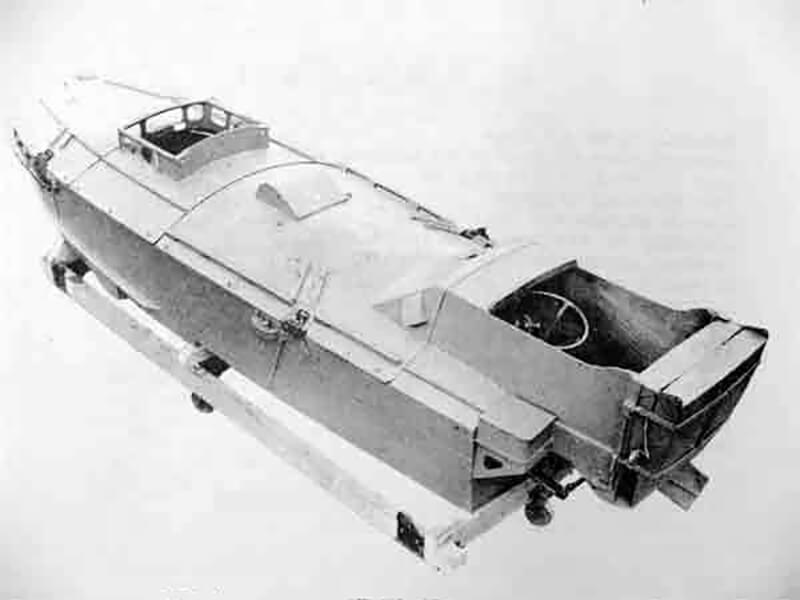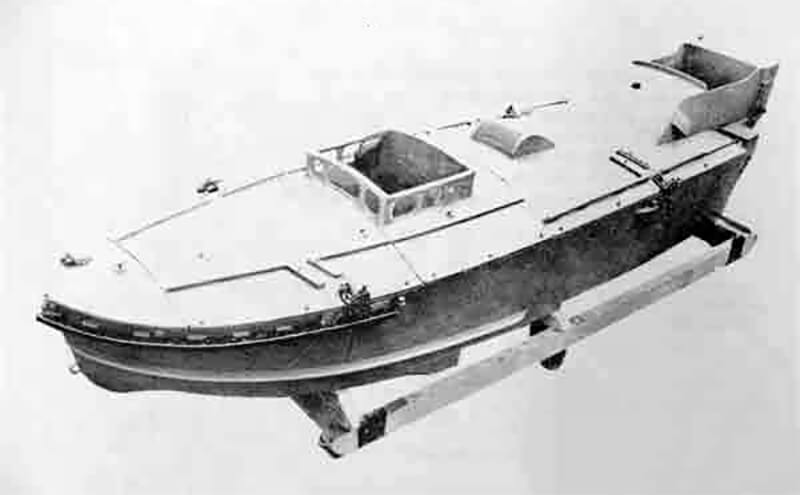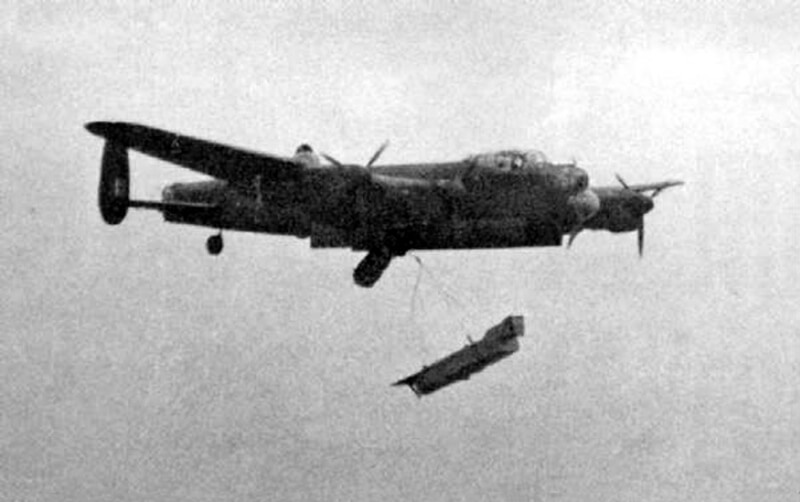| Length |
| 5.5 metres |
| Wide |
| 1.52 metres |
| Height |
| Weight |
| 1.5 tons |
| Propulsion |
| 12-cylinder, 140 horsepower Gray Fireball internal combustion engine |
| Armour |
| – |
| Armament |
| 226 kilograms of TNT |
| History |

On the January 26th, 1942, Major Herbert George “Blondie” Hasler takes up his role within the Combined Operations Development Unit under the command of Captain T.A. Hussey Royal Navy, (Previously known as the Inter-Services Training and Development Centre) located at the Royal Marines Eastney Barracks, Southsea. The primary mission of this unit involves the research and development of novel equipment, crafts, and materials to enhance amphibious warfare capabilities. This unit, with great foresight and sharp judgment but limited funding, has prepared excellent pre-war plans and developed the first of the assault landing crafts that would later prove invaluable.
Upon joining the Combined Operations Development Centre (CODC), Major Hasler immediately dives into his work with zeal. On his first day, he travels with Captain Hussey to Gosport to inspect an Italian “explosive motorboat” seized during the enemy’s attack on Malta on July 26th, 1941. The next day, he heads to the Combined Operations Headquarters (COHQ) for a meeting with Lord Mountbatten, facilitated by Tom Hussey, where his drafted terms of reference are approved. Hasler is tasked with studying, coordinating, and developing stealthy seaborne attacks by very small parties, focusing particularly on developing a British version of the explosive motorboat and enhancing methods for attacking ships in harbour. Consistent with the practices of British Special Forces at that time, the project is given a deliberately misleading name, known as the Boom Patrol Boat.
Hasler engages deeply in research on various devices and collaborates with numerous military and civilian experts. He leads a small ‘Experimental Party’ in Southsea, training them intensively. His initial projects revolve around the explosive boat, working closely with Vosper’s boatbuilders to adapt the Italian high-speed planing motorboat, equipped with a 225-kilogram charge at the bow, into a British variant. This version, named Boom Patrol Boat (BPB), is designed to allow the pilot to escape, unlike the Italian model where operators often surrendered after their missions.
On April 15th, 1941, Hasler’s focus pivots back to Boom Patrol Boats after looking into the development of the Cockle Mk. II Canoe and the use of the Davis Diving equipment. He drafts a development paper that stresses the need for Boom Patrol Boats to be air transportable and launchable, which are currently under trials at Vosper’s. He presents this innovative document to Combined Operations Headquarters, sparking significant innovative ideas. After revising and gaining approval, Hasler elaborates on air transport methods at Combined Operations Headquarters.
Seeking to transition from experimental setups to operational deployment himself, Hasler gets a great idea on April 20th, 1942. Hasler thinks about establishing a dedicated unit. He envisions this unit using both Boom Patrol Boats and canoes, where canoes would manage surface obstructions and facilitate extraction after missions. This leads to discussions with Hussey about creating a Royal Marine unit under the guise of harbor patrol to mask their true purpose. The proposal emphasises the need for exceptionally high morale among the personnel.
On April 24th, 1942, Hasler pitches the formation of the Royal Marines Harbour Patrol Detachment at Combined Operations Headquarters During this meeting he highlights its defensive role to win support from the Commander-in-Chief, Portsmouth. Lieutenant-Colonel H.F.G. Langley, Royal Artillery formalises this proposal on May 12th, 1942, advocating the joint operational capabilities of Boom Patrol Boats and Canoes to handle surface obstructions and aid in operations. In brief, the canoes handle obstructions and defenses, preparing the operational area for the Boom Patrol Boats to enter and complete the mission. The canoes then assist the pilots, who evacuate their boats before hitting their target, to escape.
As the Royal Marine Boom Patrol Detachment undergoes formation and training, the Vosper Company is commisioned with tbuilding the craft designating it as the Vosper EMB (Explosive Motor Boat). The company encounters a major challenge in sourcing a suitable engine for the boats. The only engine with sufficient horsepower available is the Lagonda V12 Engine, originally from the Lagonda V12 car. This engine must be removed and modified to fit the vessel; however, it turns out to be too heavy. As a result, the Vosper Company is urgently exploring alternative engine options. Halfway 1943 Vosper’s manages to fit the American-built, 12-cylinder, 140 horsepower Gray Fireball internal combustion engine, it achieves a maximum speed of over 55.5 kilometres/hour, with an operational range of about 111 kilometres at cruising speed. The craft weighs approximately 1.5 tons, measuring 5.5 metres in length and 1.52 metres in beam.
The Boom Patrol Boat’s bow-mounted charge, containing around 226 kilograms of TNT. However, its fuzing system, comprising impact, hydrostatic, and time-fuze options, is electrical rather than mechanical, allowing the pilot to choose the desired setting at any point during an attack.
By mid-1943, the first version of the Boom Patrol Boat enters its testing phase. In Chichester Harbour, the unit adapts a sailing barge named the Celtic for use in training with the Boom Patrol Boat. The Celtic serves as a training base for the Boom Patrol Boats, accommodating the training boats which can be lifted out of the water. After some initial training in Chichester Harbour, the Celtic sails up to Scotland, near Oban in Loch Creran just off Loch Linnhe, with another temporary operational base in Lerwick on the Shetland Islands. At the advanced operational training base, they also take possession of the Combined Operations depot ship H.M.S. Quentin Roosevelt. Here, they set up advanced training with the Boom Patrol Boats, the cockle canoes, and the intermediate carriers, preparing for the future of the unit. This location allows them to practice with their equipment discreetly.
| Airdrop |
Hasler’s innovation extend to exploring alternative transport and delivery methods, including discussions with the Royal Air Force and civilian designers about launching small craft and swimmers from aircraft into enemy waters. A significant advancement includes adapting the explosive motorboat to be air-dropped by parachute, with trials conducted by Sir Raymond Quilter of G.Q. Parachutes Ltd.
The Royal Air Force refers to this project as the Skylark. Development begins with an air-dropped design, which is delivered to the target by a Lancaster bomber. Over the target area, the pilot climbs into the craft, wearing underwater breathing apparatus and a personal parachute. At 1,500 metres, the craft is launched into the air. Three parachutes then deploy to lower the craft to the sea below, disengaging themselves once the craft is afloat. Although the diver wears a personal parachute, it is highly doubtful whether he could ever extricate himself from the craft to use it. Most of the development took place at the Royal Aircraft Establishment (RAE) the British Royal Air Force research establishment in Farnborough, Hampshire. In charge is aero engineer Harold Billett.
It took some time before the unit is able to drop a piece of equipment with a significant weight into the sea. During several of the initial trials weight detached from the parachutes in mid-air. After some five drops the unit attached a prototype boat to the parachute and drops it into Chichester Harbour. The boat crashes on impact. It takes them until June 1944 before they can do a live drop with a man in it. By then Major Stewart had taken over the command of the Royal Marine Boom Patrol Detachment as Major Hasler has left for the Far East.
As Major Stewart prepares to make the first drop himself, he is forbidden by Combined Operations Headquarters to do so. Instead lieutenant David Cox carries out the first drop successfully.
In later experiments, the resulting boat is slightly smaller, featuring a compartment amidships where the pilot crouches while the boat is parachuted from the aircraft. The aircraft, flying at 230 kilometres/hour at an altitude of 250 metres, is piloted directly over the target into the wind before releasing the boat. The boat then drifts backwards over the target and into the water. The Boom Patrol Boat pilot then moves from his cubby hole to the cockpit at the extreme rear of the craft. Once the parachutes are jettisoned, the boat races towards the target at speeds of up to seventy-five kilometres/hour, with the pilot abandoning it in a manner similar to the Italian design. The air-drop method is assessed by the air force, which gives the Boom Patrol Boat a 50 % chance of hitting the water in a satisfactory condition, temporarily disregarding the risks of the boat being targeted as it descends by parachute. Live tests are conducted with men from Royal Marine Boom Patrol Detachment, and, fortunately, no lives are lost, although the process remains incredibly dangerous.
| Escape Backrest |
Originally, the Boom Patrol Boats featured a wooden raft known as a backrest, used as an escape platform after deploying the boat’s explosives either upon impact or via a hydrostatic trigger that activated the explosives about 3.7 metres below the waterline. After setting the boat’s course and deploying the explosives, operatives had to quickly retreat to the backrest to distance themselves from the blast effects at a range of approximately 90 to 120 meters.
This concept was adapted from the wooden backrest of the boom patrol boats to create a rubberized suitcase, which could carry not only explosives but also essential escape gear, transforming it into a multifunctional tool for covert operations.
From this Dunlop develops the suitcase raft. This is an ingeniously design of an inflatable raft, similar to what might be referred to as a flutter board. An important innovation not previously mentioned is the use of swim fins, which significantly enhance underwater mobility and speed. The suitcase itself, crafted from rubberized material, served not just as storage but also as a buoyant support to rest on while propelling through the water with swim fins.
While the design offered substantial advantages, it also presented challenges, especially when parachuting. The main concern was to prevent the suitcase from entangling with the parachute upon deployment. By securing it appropriately, it was possible to avoid potential mishaps associated with the parachute lines.
| Multimedia |
| Photographs |




